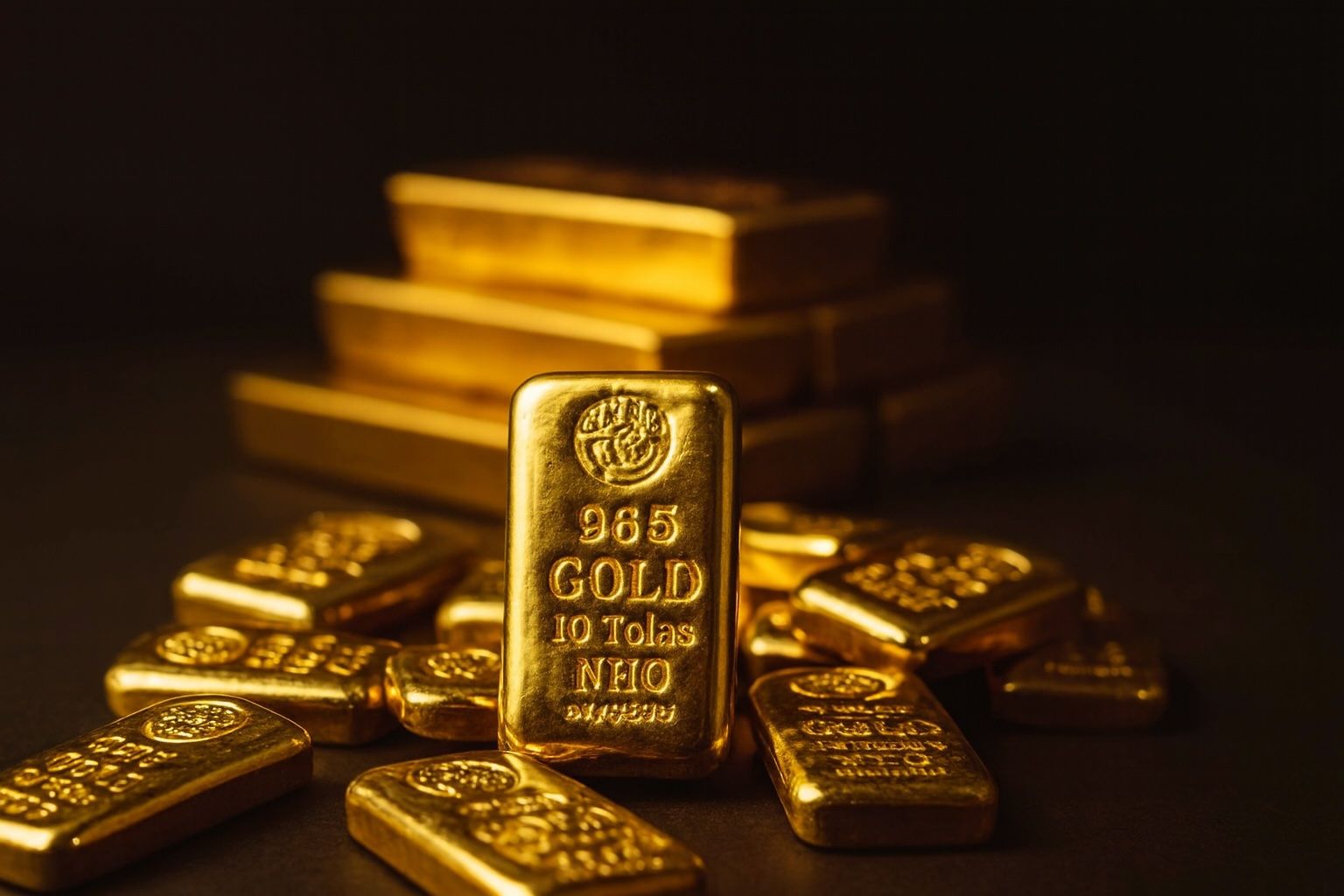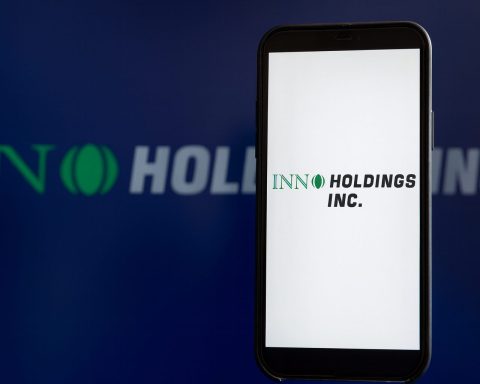- Global Record: Gold prices soared to record levels on October 6, 2025, with spot gold surging past $3,900 per ounce for the first time ever [1]. This milestone reflects a rush into safe-haven assets amid worldwide economic jitters.
- India at All-Time High: India’s gold rates have mirrored the global spike. 24-carat gold crossed ₹12,000 per gram (about ₹1,20,000 per 10 grams) – an unprecedented high [2] – while 22-carat gold jumped above ₹11,000 per gram. Major Indian cities like Delhi and Mumbai saw 24K prices around ₹12,077/gram on Oct 6 [3], continuing an upward trend that began with historic highs in early October [4]. Silver is also shining: Indian silver futures hit record highs near ₹1,48,000 per kg in tandem with gold’s climb [5].
- Surge Drivers – U.S. Turmoil & Festive Demand: Investors are flocking to gold due to a perfect storm of global factors. Foremost is safe-haven buying sparked by U.S. economic uncertainty – notably the threat of a U.S. government shutdown and policy jitters under President Donald Trump’s administration [6]. These concerns, coupled with a weaker dollar and expectations of Federal Reserve interest rate cuts, have made non-yielding gold more attractive [7]. At the same time, seasonal demand is boosting prices – India’s Diwali festive season and China’s Golden Week holiday have unleashed a wave of jewelry and investment purchases [8] [9]. Ongoing geopolitical tensions (such as the Russia-Ukraine conflict) and currency market volatility (e.g. a sharply weaker yen) further fuel the flight to safety [10] [11].
- 50%+ Price Jump in 2025: The yellow metal’s rally has been dramatic. In India, spot gold prices have surged over 50% in 2025 to date [12], making gold one of the year’s top-performing asset classes. Globally, gold’s ascent – now nearing the $4,000/oz mark – underscores its role as a hedge against inflation and crisis. Central banks have been bolstering their reserves as well, with an additional 15 tonnes of gold bought in recent months, signaling long-term confidence in the metal [13].
- Expert Advice – Caution on Buying at Peak: Financial experts caution that while the bullish momentum may continue, would-be buyers should not panic-buy at peak prices. Minor corrections are likely; many analysts advise using any dips as buying opportunities rather than chasing the rally [14]. Gold is viewed as a long-term “insurance” asset – a safeguard against inflation, currency weakness, and shocks – rather than a quick-profit trade [15]. Investors with upcoming needs (e.g. weddings or portfolio diversification goals) are advised to accumulate gradually (via jewelry, coins or digital gold) instead of trying to time the absolute top [16].
Global Gold Prices Break All Records
Gold’s latest surge is truly global in scale. In early Asian trading on October 6, the precious metal breached the $3,900 per ounce barrier for the first time in history [17]. It even spiked to intraday highs around $3,920–$3,924 before steadying just below $3,920 [18] [19]. This marks a new all-time record for gold internationally, eclipsing the previous highs set during recent economic turbulence. By afternoon, U.S. gold futures were trading robustly around $3,935/oz [20], reflecting strong sentiment.
The global rally is being driven by intense safe-haven demand. Investors worldwide have poured into gold as a shelter from financial storms. A major catalyst is the United States’ fiscal standoff – the prospect (and reality) of a U.S. government shutdown has rattled markets and “added to the momentum” pushing gold higher [21]. With parts of the U.S. government at risk of going dark, key economic data releases have been delayed, feeding uncertainty in markets [22]. This uncertainty is amplified by policy moves from Washington. Notably, President Trump’s trade and immigration policies have introduced new question marks for global growth, leading investors to seek safety; as one report noted, “uncertainty surrounding US President Donald Trump’s tariff and immigration policies” has been a significant factor behind gold’s rise [23].
Another global driver is monetary policy expectations. There is a growing belief that the U.S. Federal Reserve may soon reverse course on its tightening cycle. The possibility of interest rate cuts on the horizon – or at least an end to rate hikes – makes gold more appealing, since lower rates reduce the opportunity cost of holding gold (a non-interest-bearing asset) [24]. On top of that, the U.S. dollar has weakened amid these expectations [25]. A softer dollar automatically lifts gold’s USD price, since gold is dollar-denominated; indeed, analysts point out that profit-taking in the dollar index and declining U.S. bond yields have given an extra push to gold and silver prices [26].
Broader geopolitical tensions are also at play. The ongoing Russia-Ukraine war is a prime example – it continues to inject uncertainty and risk into the global environment [27]. Other flashpoints and conflict concerns keep investors on edge. In such times, gold is often seen as “a shield during troubled times,” as it holds its value when other assets falter [28]. Ponmudi R., CEO of Enrich Money, observes that gold hovering around $3,900/oz signals steady safe-haven demand – importantly, this has not yet “unsettled broader risk appetite,” meaning stock markets haven’t crashed, but investors are quietly repositioning for safety [29]. This reflects a constructive sentiment: people are hedging their bets with gold without outright panic.
It’s not just individual investors; central banks and institutions have been large players in gold’s ascent. Central banks worldwide have been steadily accumulating gold for reserve portfolios. In fact, global central banks added roughly 15 tonnes of gold to reserves in a single month of late summer 2025, according to World Gold Council data [30]. This heavy buying by China, India, and other central banks demonstrates long-term confidence in gold’s value [31]. (It’s worth noting the World Gold Council did caution that gold’s rapid price rise might temper central bank buying in the immediate term [32], but the trend of accumulation remains strong.) Institutional investors are joining in via financial instruments – gold-backed ETFs have seen increased inflows during this rally, indicating even large funds are moving into gold [33].
India Sees All-Time Highs Amid Festive Rush
In India – the world’s second-largest gold consumer – prices have hit all-time highs in rupee terms, intensifying the gold fever. By October 6, 24K gold (99.9% purity) was retailing around ₹12,077 per gram on average, after jumping by over ₹130 in a single day [34]. For context, ₹12,077/gram translates to about ₹1,20,770 per 10 grams, a traditional benchmark, and this breached the previous record. 22K gold, the common purity for jewelry, climbed to roughly ₹11,070 per gram [35]. Even 18K gold (popular in some ornaments) hit ~₹9,058/gram [36]. These rates vary slightly by city (accounting for local taxes and transport), but virtually every major city – from Chennai and Kolkata to Mumbai and Delhi – saw new peak prices in the first week of October [37] [38]. The rally had briefly cooled in late September with minor corrections, but as of Monday it roared back, with Indian prices “reaching near their record highs on Sunday” and pushing even higher on Monday [39].
A key factor in India’s gold price surge is seasonal and cultural demand. October marks the start of the festive period culminating in Diwali (Nov 2025), which is traditionally a gold-buying season. Many Indians buy gold jewelry and coins during festivals like Dussehra and Diwali for auspicious reasons. Jewelers report robust footfalls; this festive buying spree has provided a strong undercurrent of demand, boosting prices “amidst festive seasonal demand in India,” as noted by The Indian Express [40]. In addition, the wedding season follows soon after Diwali – another period of heavy gold purchasing. This local demand uptick coincides with the global factors, amplifying the price gains in rupee terms.
Indian gold prices also take cues from the global market via the import parity price. With international gold at record highs in dollars, and the Indian rupee facing its own pressures (the rupee has seen some weakness against the dollar [41]), the landed cost of gold in India has risen sharply. India imports most of its gold, so a weaker rupee makes gold imports costlier, translating to higher domestic prices. The result: Indian gold is hitting records not just because of local demand, but also due to currency effects and import costs riding on the global rally.
Moreover, Indian markets have their own benchmark: the Multi Commodity Exchange (MCX) futures. MCX December gold futures rocketed to ₹1,19,928 per 10 grams intraday on Oct 6 [42], the highest ever. That futures price aligns closely with the spot – it signals traders expect high prices to sustain through year-end. Silver, too, has joined the party in India. On the same day, MCX silver futures touched about ₹1,47,700 per kilogram [43], a fresh peak, echoing gold’s move as investors also see silver as a safe haven and an industrial metal beneficiary. In major cities, physical silver rates topped ₹1,46,000/kg for bullion and even higher for finer purity [44].
The breadth of the rally is clear: both urban investment demand and rural jewelry demand in India are strong. Even small corrections in price last week did little to dent shopper enthusiasm, as many rushed to buy in fear of even higher rates. Gold sellers note that consumers are sensitive to price dips – any slight drop in price is triggering bargain buying, which in turn propels prices back up. This dynamic has kept Indian gold at elevated levels continually.
Why Are Gold Prices Soaring? Key Drivers
Multiple converging factors explain why gold is in the midst of a record-breaking rally. Here are the key drivers behind the surge:
- Safe-Haven Demand from Economic Uncertainty: When uncertainty rises, gold shines. Right now, fears of a U.S. economic crisis are front and center. The U.S. government came to the brink of a shutdown (and indeed parts of the government have been shut) due to budget deadlocks, which “pushed investors toward gold” as a safety measure [45]. Additionally, concerns about the direction of U.S. policy under the new administration have spooked markets – the tariff and immigration moves by President Trump have raised questions about global trade and growth [46]. Investors respond by moving money into gold, which historically holds its value during political or financial upheaval. Gold’s surge in early October was “driven by strong spot market demand ahead of Diwali, along with positive global cues,” essentially a combination of local buying and international safe-haven sentiment [47].
- Interest Rate & Dollar Factors: Gold’s appeal grows when returns on other assets look less attractive. There’s a widespread expectation that the U.S. Federal Reserve will cut interest rates in the near future, especially if economic growth slows. Such expectations have been “a key positive factor” for gold’s rise [48]. Lower interest rates reduce bond yields and savings rates, thereby making zero-yield gold comparatively more lucrative to hold. At the same time, the U.S. dollar has been weakening on these expectations. The dollar index recently pulled back after a period of strength [49]. A weaker dollar directly boosts gold’s price (since gold is priced in USD globally). This double-effect – lower yields and a soft dollar – is a classic recipe for higher gold prices. As Rahul Kalantri, VP of Commodities at Mehta Equities, explains: “Declining US bond yields, [and] geopolitical uncertainties, and the US government shutdown” have given gold and silver strong support in recent weeks [50]. Essentially, the opportunity cost of holding gold has fallen, and its safe-haven appeal has risen.
- Geopolitical Tensions and Crisis Fears: The world is not short on crises, and each adds to gold’s luster. The war in Ukraine continues with no clear end in sight, keeping Europe on edge and contributing to global risk aversion [51]. Elsewhere, trade tensions and diplomatic strains (for example, U.S.-China strategic competition) are simmering. Even if stock markets have been resilient so far, these persistent risks drive some investors to quietly accumulate gold as a hedge. Gold is often dubbed the “crisis commodity” – when conflicts or disasters loom, gold demand often rises. Right now, that pattern is evident: ongoing conflicts and the general “global uncertainty” are “keeping geopolitical risks high,” which in turn is pushing gold prices up [52].
- Surge in Physical Demand (India & China): Beyond investors and central banks, consumer demand for gold jewelry and bars has spiked in key markets. In India, as discussed, the Diwali festival and an upcoming busy wedding season have traditionally led to buying spurts – this year is no exception, except prices are the highest ever. Jewelers in India are reporting increased foot traffic despite high prices, as consumers fear prices could rise further if they wait. Similarly, in China, the week-long National Day holiday (Golden Week in early October) saw exceptionally strong gold sales. Major Chinese gold retailers raised prices above 1,100 yuan/gram (≈ $155/gram) during the holiday, and shops in gold hubs like Shenzhen saw a surge in customers, with some stores seeing 10% more visitors than last year’s holiday [53] [54]. This robust Asian retail demand provides a fundamental floor under global prices. When millions buy gold earrings, coins, or bars for cultural reasons (despite the high rates), it tightens supply and supports the price rally.
- Central Bank Buying: A significant, less-visible support for gold has been aggressive buying by central banks. Nations like China, India, Turkey, and Russia have been accumulating gold reserves in recent years as a strategy to diversify away from the U.S. dollar. That trend has continued into 2025. In fact, data shows central banks collectively added about 15 tons of gold to reserves in a single month (August 2025) [55], and continued purchases into September [56]. This official sector demand boosts gold not only through the direct increase in demand, but also by reinforcing market sentiment that big players trust gold’s long-term value. When investors see central banks hoarding gold, it validates gold’s role as a stable store of value, encouraging even more private investment.
- Momentum & Technical Triggers: Lastly, part of the rally can be attributed to market momentum and technical factors. Leading up to the record spike, gold had been trading in a range for a few weeks, “consolidating in previous sessions” [57]. Once it decisively broke out above a key resistance level (around $3,880/oz as noted by technical analysts [58]), it triggered a wave of fresh buying by trend-following traders. This kind of breakout prompts algorithmic trading systems and momentum investors to jump in, further propelling the price in a short span. Analysts identified next resistance levels around $3,950 to $3,970 – and indeed gold nearly tested those in intraday trade [59]. Such technical breakouts amplify fundamental-driven moves. In simpler terms, as the price kept making new highs, it attracted more buyers (“fear of missing out” in the rally), creating a self-reinforcing cycle – until something breaks the momentum.
All these drivers combined have created a potent rally. The overall picture is one of widespread risk aversion and recalibration by investors globally. Gold has reasserted itself as the asset of choice when confidence in paper assets or government policies falters. As a result, 2025’s run-up has firmly established gold’s status as a reliable hedge in uncertain times, with year-to-date gains well into double digits across currencies [60].
What Market Experts Are Saying
The staggering ascent of gold has caught the attention of market experts and financial advisors, many of whom are now weighing in on what’s next. Rahul Kalantri, a commodities analyst, noted that the precious metals have had “another strong week, with gold and silver extending gains and touching record highs” [61]. He attributes this strength to a confluence of supportive factors – notably the weaker dollar and lower bond yields after the U.S. Fed’s dovish signals, geopolitical tensions, and the U.S. government shutdown, all of which provided a tailwind for gold [62]. Kalantri also pointed out a telling sign of confidence: central banks (including India’s) added 15 tonnes of gold to their reserves in September, reflecting “long-term confidence in the metal.” [63] In other words, big institutional players are betting on gold for the long haul, which retail investors might take as a cue.
Another perspective comes from Ponmudi R., CEO of Enrich Money, who highlighted that gold’s ascent to roughly $3,900 hasn’t caused panic elsewhere, but it shows a steady undercurrent of safe-haven demand. “Gold remains around $3,900 an ounce, signalling steady safe-haven demand but without unsettling broader risk appetite,” Ponmudi observed [64]. This suggests that investors are hedging by buying gold while still participating in stock or risk markets – a sign of a constructive, if cautious, sentiment in the financial world.
Financial firms are advising clients on strategic allocations. Tata Mutual Fund, for instance, recommends maintaining exposure to gold given the macro backdrop. They foresee gold possibly trading in a broad range of $3,500–$4,000/oz in the short term as markets digest the latest developments [65]. Tata MF’s advice to investors: “remain invested and look for accumulation on any decline” in prices [66]. They emphasize that the current environment – marked by inflation concerns, geopolitical uncertainty, and currency fluctuations – is favorable for a strategic allocation to gold as a percentage of one’s portfolio [67]. In fact, the fund house suggests that investors consider a mix of precious metals, for example a 50:50 allocation between gold and silver, since “silver too looks attractive” alongside gold as a long-term hedge [68]. The rationale is that as safe-haven flows continue, both of these metals could rise, and silver also has industrial demand factors that could drive it higher.
From a more short-term trading angle, commodity experts are providing levels and targets. Anuj Gupta, a SEBI-registered analyst, was quoted saying gold and silver likely “may remain on an upward trajectory amid global uncertainty, Fed rate cut expectations and dollar weakness.” He even forecasts that by the end of 2025, gold in India could reach around ₹1,20,000 per 10 grams (and silver ₹1,50,000 per kg) if current trends persist [69]. Gupta’s optimistic take is that the rally has room to run, though he too acknowledges it’s driven by macro uncertainties.
Meanwhile, technical experts like Manoj Kumar Jain of Prithvifinmart are advising traders to buy on dips with tight stop-loss orders, reflecting some caution. He identified support levels for global gold around $3,860–$3,884 and resistance around $3,922–$3,950 per ounce in the very near term [70]. This essentially means that even within this rally, gold is seeing volatile swings, but staying within an upward channel. Jain’s advice for day-to-day traders was to consider accumulating around dips (e.g. near ₹1,17,700 per 10g on MCX) with targets back toward the highs (₹1,19,500+ in the short run) [71]. Such granular guidance underscores that while the trend is up, volatility is high – prices can move quickly both up and down in short spans.
Market veterans also point to investor sentiment measures. The increased inflows into gold Exchange-Traded Funds (ETFs) is a sign that not just retail, but also institutional investors, are hedging portfolios with gold [72]. Often, rising ETF demand correlates with sustained price strength, as these funds have to buy physical gold to back the shares. It’s a reinforcing cycle: higher prices attract more investors seeking momentum or safety, which then drives additional buying.
In summary, expert commentary converges on a few themes: cautious optimism and strategic patience. There’s a broad agreement that the factors propelling gold are unlikely to disappear overnight – the U.S. fiscal situation, rate policy shifts, geopolitical tensions, and robust demand are likely to persist in the coming months. However, there’s also a clear message that investors should not get carried away by euphoria; instead, they should maintain a balanced approach, keeping an eye on corrections and not overextending at record prices.
Should You Buy Gold Now or Wait?
With gold and even silver at record highs, a pressing question for many individuals is: Is this the right time to invest in gold, or should one wait for a pullback? The answer, according to most financial advisors, lies in one’s investment horizon and goals – and in exercising caution despite the glittering headlines.
Short-Term vs Long-Term Perspective: If you are looking for a quick profit, jumping in at record-high prices is inherently risky. Gold prices can be volatile. In fact, after such a steep run-up, analysts widely anticipate the possibility of short-term corrections – small price declines that could occur if, say, there’s progress on U.S. budget talks or a surprising shift in interest rates. Many experts suggest that any such dip should be viewed as a buying opportunity for those who want to accumulate gold [73], rather than a sign to panic. The idea is to gradually build your exposure. “Small corrections may occur along the way. Many believe such dips could be used as buying opportunities, especially for long-term holders,” notes India Today’s analysis of expert views [74]. In essence, don’t try to time the absolute peak or trough – instead, if you plan to invest, consider phasing your purchase.
Gold’s Role in a Portfolio: It’s important to remember why one buys gold in the first place. Traditionally, gold is not meant to yield quick high returns like a hot stock might. Rather, “Gold may not offer quick returns, but it has traditionally served as a strong insurance against inflation, currency weakness, and economic shocks,” an India Today Business Desk report reminds readers [75]. If you’re worried about rising living costs, a weakening currency, or financial crises, gold is a form of protection. Therefore, those considering buying at these prices should ensure they are doing so for the right reasons – chiefly, as a hedge or long-term safety net, not purely speculative gain. Over decades, gold has preserved and grown wealth (2025 is a testament, with over 50% jump in less than a year [76]), but it can underperform other assets in boom times. Thus, financial planners often advise holding gold as 5-10% of a diversified portfolio rather than betting everything on it.
When to Buy – Expert Tips: For individuals planning large gold purchases – say for a wedding or major investment – experts suggest not waiting indefinitely, but also not buying all at once at peak price. A prudent approach is staggered buying. For example, if one needs X grams of gold over the next year, buying in tranches on different days or months can average out the cost. This way, if prices dip after a record high, one can take advantage of the lower price for the next tranche. If prices keep rising, at least one has already purchased some portion. As one expert put it simply, “Those looking to invest should consider their financial goals rather than trying to time the market perfectly.” [77] If your goal is long-term (children’s marriage, retirement, wealth preservation), time in the market beats timing the market – meaning it’s more important to have some gold in your portfolio than to stress over the perfect entry point.
For small investors or first-time gold buyers, modern avenues like digital gold or gold ETFs can be a convenient way to start, as they allow buying very small quantities (even a fraction of a gram) at transparent market-linked prices. Accumulating gold in these forms during periodic dips might be easier than timing visits to the jeweler. However, for cultural purchases like jewelry for a wedding, where the timing is fixed, one might consider hedging by buying some portion early. Remember that jewelry incurs making charges, so from an investment standpoint, gold coins or bars (or digital equivalents) might yield better value if the intent is pure investment.
Silver Consideration: The rally in silver, often called the “poor man’s gold,” is also noteworthy. If one’s objective is purely investment and hedging, silver could be an interesting addition. Its price behavior is correlated with gold but also tied to industrial demand (solar panels, electronics, etc.), which means it can sometimes lag or outpace gold. Some advisors, like those at Tata Mutual Fund, even suggest a 50:50 allocation between gold and silver for hedge-seeking investors [78]. Silver is more volatile but has hit record highs alongside gold, indicating its co-status as a refuge asset now [79]. As always, any investment in precious metals should be aligned with one’s risk tolerance – silver’s higher volatility means sharper swings.
Bottom Line: If you are thinking about buying gold now, do so with clear eyes. The consensus of experts is that gold’s fundamentals are strong in the current environment – global risks and monetary easing bias could keep prices elevated or rising. Long-term believers in gold’s value argue that even at ₹12,000/gram or $3,900/oz, the metal can hold value over time, especially if inflation persists or currencies depreciate. However, practically no one is suggesting to rush in with all your funds at once. A measured approach is key. As one market report put it, gold remains a “reliable safety net” – just make sure to buy it wisely and for the right reasons [80]. That might mean buying a bit now, a bit later, and focusing on gold’s role as a hedge, not a get-rich-quick asset.
In summary, the gold price boom of late 2025 is a reflection of the uneasy state of the world – and gold’s enduring appeal as a safe harbor. It has rewarded those who held it through the year, and it’s causing new investors to take notice. Whether you decide to jump on the bandwagon now or wait for a calmer moment, the overarching advice from experts is clear: keep perspective. Gold’s glitter has stood the test of time, but investing in it should align with your long-term strategy. Enjoy the shine, but don’t get blinded by it.
Sources: Gold price data and expert quotes from recent reports by The Indian Express, Mint, India Today, Reuters and others [81] [82] [83] [84] provide the factual foundation for this report. These outlets chronicle how gold hit historic highs due to a mix of U.S. fiscal woes, Fed policy shifts, geopolitical tensions, and surging festive demand – painting a comprehensive picture of gold’s momentous rally in October 2025.
References
1. www.reuters.com, 2. indianexpress.com, 3. indianexpress.com, 4. indianexpress.com, 5. www.livemint.com, 6. www.livemint.com, 7. www.indiatoday.in, 8. www.livemint.com, 9. indianexpress.com, 10. www.indiatoday.in, 11. www.newindianexpress.com, 12. www.livemint.com, 13. www.indiatoday.in, 14. www.indiatoday.in, 15. www.indiatoday.in, 16. www.indiatoday.in, 17. www.reuters.com, 18. www.newindianexpress.com, 19. www.newindianexpress.com, 20. www.reuters.com, 21. www.reuters.com, 22. www.indiatoday.in, 23. www.livemint.com, 24. www.indiatoday.in, 25. www.indiatoday.in, 26. www.indiatoday.in, 27. www.indiatoday.in, 28. www.indiatoday.in, 29. www.indiatoday.in, 30. www.indiatoday.in, 31. www.livemint.com, 32. www.globaltimes.cn, 33. www.indiatoday.in, 34. indianexpress.com, 35. indianexpress.com, 36. indianexpress.com, 37. indianexpress.com, 38. indianexpress.com, 39. indianexpress.com, 40. indianexpress.com, 41. www.reuters.com, 42. www.livemint.com, 43. www.livemint.com, 44. www.livemint.com, 45. www.newindianexpress.com, 46. www.livemint.com, 47. www.livemint.com, 48. www.livemint.com, 49. www.indiatoday.in, 50. www.indiatoday.in, 51. www.indiatoday.in, 52. www.indiatoday.in, 53. www.globaltimes.cn, 54. www.globaltimes.cn, 55. www.globaltimes.cn, 56. www.indiatoday.in, 57. www.newindianexpress.com, 58. www.newindianexpress.com, 59. www.newindianexpress.com, 60. www.livemint.com, 61. www.indiatoday.in, 62. www.indiatoday.in, 63. www.indiatoday.in, 64. www.indiatoday.in, 65. www.livemint.com, 66. www.livemint.com, 67. www.livemint.com, 68. www.livemint.com, 69. www.livemint.com, 70. www.livemint.com, 71. www.livemint.com, 72. www.indiatoday.in, 73. www.indiatoday.in, 74. www.indiatoday.in, 75. www.indiatoday.in, 76. www.livemint.com, 77. www.indiatoday.in, 78. www.livemint.com, 79. www.livemint.com, 80. www.indiatoday.in, 81. indianexpress.com, 82. www.livemint.com, 83. www.indiatoday.in, 84. www.livemint.com










